INDUSTRIAL &
TERMINAL RAILROADS &
RAIL-MARINE OPERATIONS
OF BROOKLYN, QUEENS, STATEN
ISLAND, BRONX &
MANHATTAN:
G & R
PACKING & RAILROAD
Bay Ridge, Brooklyn
Bay Ridge Division Branch - Long Island Rail Road New York New Haven Hartford Penn Central Railroad
.
.
updated: |
||
|
|
||
update summary: |
date: | |
| 1984 Porter 20 Ton photo added | 3/26/2011 | |
| G & R Packing business | 2/28/2011 | |
| rear 3/4 view of Red Ball Express critter added | 2/2/2011 | |
.
.

Property
.
During a telephone call on April 1, 2009 with Matt Herson, he informed me of a little industrial switcher that operated in the vicinity of Eighth Avenue and 63rd Street in Brooklyn that he photographed in 1962.
Matt described the location as being adjacent to the 8th Avenue Station of the Sea Beach Line, but could not offer any further info as to the nature of the industry. I located the subway station on both an obsolete and current subway map, then the general vicinity a street atlas and finally the actual property by aerial photo online. Once I had the location fixed to a specific block, I contacted Dave Keller, a noted authority on Long Island Rail Road history.
Dave was able to review the Robert Emery Maps of the Long Island Rail Road's Bay Ridge Division he has at his disposal, and quickly ascertained the location in question, which was originally the shared Long Island Rail Road / New York, New Haven and Hartford Railroad's "Eighth Avenue Engine Servicing Facility":
"The location in question south of the LIRR's Bay Ridge branch tracks (and the 8th Avenue station of the Sea Beach line crossing diagonally above) was the LIRR's Bay Ridge locomotive service facility until 1957.
The site included a 2-stall engine house, inspection pits, lighting towers, a sand house and sidings for hopper cars. It also hosted old MU car #1445 which served as a bunkhouse for New Haven engine crews.
All this was removed in 1957 as were the overhead power wires, eliminating any electrification of the tracks in question. The same year (1957), this entire area was acquired by the G & R Packing Corp.
No idea what's there now nor how long G&R remained in business or even what TYPE of business G&R was that required their own switcher, but, seeing that the LIRR probably left some or all of their tracks intact, it would make sense that whoever came afterwards would be able to use their own "dinky" on the existing former LIRR tracks should it be necessary.
There is NO indication of a siding to service G&R, but that's because the map was drawn around the time that all the loco facilities were being torn up. Perhaps a siding was left afterwards and used, allowing the LIRR to spot cars and the commercial enterprise pick them up with their switcher and move them as necessary on their property."
.
On 28 February 2011, I located the following in Google Books. The pertinant excerpt is reproduced here:
In the matter of Sea-Land Service, Inc., January 14, 1977:
This decision is in response to a claim submitted by Sea-Land Service, Inc. (Sea-Land), for $91,665.40 in earned ocean freight which was withheld by means of setoff against a cargo damage claim of the United States. Sea-Land protests the Government's withholding of the sum equal to its cargo damage claim, and argues that the Government has no right of common law setoff.
Sea-Land, a common carrier by water, received for transportation in March 1972 two shipments of palletized, canned, dried nuts loaded into three Sea-Land containers. The shipments were transported from Brooklyn, New York, to the Defense Depot, Tracy, California, and to the Naval Supply Center, Alameda, California, under Government bills of lading (GBLs) Nos. F-2715761 and F-2715762. These shipments transited the Panama Canal and were delivered to the Government in California on April 20, 24, and 25,1972. Both shipments were rejected by the consignee; rejection was predicated upon evidence of moderate to extensive rust (moisture damage) to the exterior of the cans, rendering the cargo unfit for military distribution.
The GBLs were issued by Sea-Land March 20 and 30, 1972, to cover the two shipments of edible nuts from G & R Packing Co. (G & R) in Brooklyn, New York, for Aster Nut Products, Inc. (Aster), of Newark, New Jersey, a Government contractor.
The Defense Contract Administration Services Region (DCASR) for New York reports that in the process of canning, these nuts are packaged by Aster in the cans in a dry condition at room temperature. The cans are packed in the shipping cases at room temperature and then placed on pallets and shipped to G & R in closed vans. At G & R the shipping cases are taken off the prime contractor's pallets and placed on military pallets. All of this work is done indoors in a covered area and at room temperature.
G & R packed and sealed 34 pallets in Sea-Land's container #30371 on March 19, 1972, and the shipment was picked up by SeaLand at G & R on March 20, 1972, under GBL No. F-2715761. The shipment was lifted aboard Sea-Land's S.S. Baltimore, which sailed from Elizabeth, New Jersey, on March 24, 1972 (voyage 86W); it was delivered by Sea-Land's agent to the Tracy Defense Depot on April 20,1972, where it was rejected to the carrier.
G & R packed 30 pallets in Sea-Land's container #33435 and 20 pallets in container #67774 on March 29, 1972, and the shipment was picked up by Sea-Land from G & R on March 30, 1972, under GBL No. F-2715762. The shipment was lifted aboard Sea-Land's S.S. Seattle, which sailed from Elizabeth, New Jersey, on April 3, 1972 (voyage 235W); it was delivered by Sea-Land's agent to the Alameda Facility Warehouse on April 24 and 25, 1972, where it was rejected to the carrier.
So, with this latest discovery, we can now conclude the G & R Packing was in the business of small food item packaging.
I located a digital copy of the Robert Emery map on Steve Lynch's LIRR website. I took some time and cleaned up the original Emery map, making it more legible, and reoriented it for north (up). The last entries were dated 1957, and I kept the original key numbers at listed on the original map:
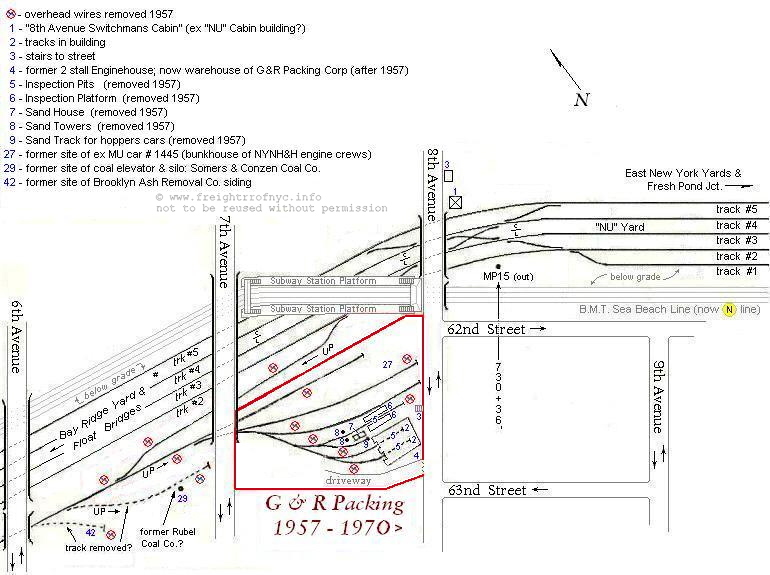
According to a Long Island Rail Road "Map of Freight Stations and Private Sidings" located on Steve Lynch's LIRR website and dated June 1966; the G & R Packing facility had a total of 6 tracks with a capacity of 35 freight cars.
For those of you not familiar with the Bay Ridge Branch
of the New York, New Haven & Hartford / Long Island Rail Road, the right
of way runs below street level from Second Avenue (Bay Ridge Yard) until
it becomes an raised embankment between Albany Avenue & Glenwood
Road.
.
| The portion of the New York, New Haven & Hartford /
Long Island Rail Road Right of Way shown on the map above and to the right,
is actually below grade (approximately 25- 30 feet below street level as
it has to pass under the B.M.T. Sea Beach Line "flyover".
As the G & R Packing property is only about 15 feet below street level, this resulted in a moderate incline up from the New York, New Haven & Hartford / Long Island Rail Road Right Of Way to the G & R Property. |
|
The side elevation illustration seen here to the right, is representative of the profile of the track levels of the various rights of way and street levels at the Seventh Avenue overpass and looking due east...
I have also been able to locate aerial images of this industry location. The first aerial image, is also from 1966 and shows what appears to be railcars and tractor trailers in the yard of the property:.

1966
(north is up)
.
.
Lapse forward to 2023, when I do my infrequent search of the web for new material. I located a US Government Public Contracts Bulletin, and within G&R Packing is listed as receiving several contracts let by the US Army in March 1949 for the packaging of "dressing, salad".
At least now we have a definitive set of dates for the existence of G & R Packing at this location: 1949 through at least 1972. Whether G & R Packing occupied this location from this early date, remains to be uncovered.
The following information comes from one of the most revered, recognized and knowledgeable sources of information pertaining to Brooklyn railroading: Mr. Ben Schaeffer on February 4, 2011. Ben relates that he spent quite a deal of his adolescence riding on the Bay Ridge local freight trick BR-1. This train would deliver and pick up cars at G & R Packing as needed. His notes also reflect that no freight cars were picked or delivered after September 1980. Furthermore, Ben has provided disposition information on the locomotive which can be read in that chapter below.
This second aerial image shown below, is from Live Search and is dated 2008; clearly shows the industry is no longer there and the property is vacant, yet the structure of the original enginehouse remains.
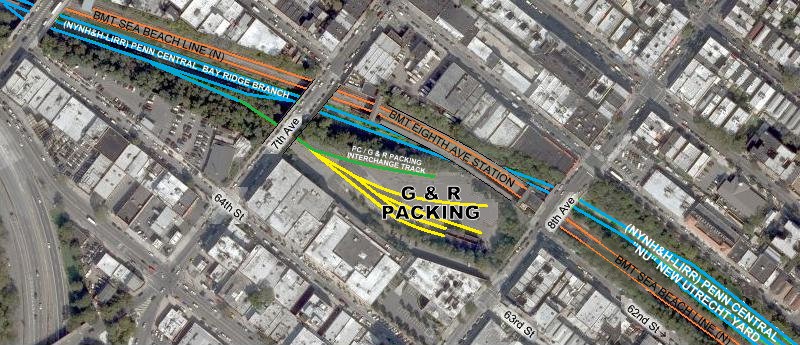
Limits of locomotive operations:
BLUE & GREEN: Long Island RR: 1949-1968, then Penn Central 1968-1972>
YELLOW & GREEN: G & R Packing 1949-1972>
.
.
According to the Robert Emery map, G & R Packing was the new tenant / owner of this property in 1957. At which point did or even if, Red Ball Express become involved remains unclear, and it is unknown if Red Ball Express leased the property from G & R Packing or simply whether the locomotive carried a logo from a former operator or in jest.
In depth research on the internet at this time, has failed to turn up any reference of Red Ball Express or even G & R Packing at this location; but research is ongoing.
On 06 September 2009, I located a single photo of G & R Packing on Joseph Korman's website of New York Shortlines:
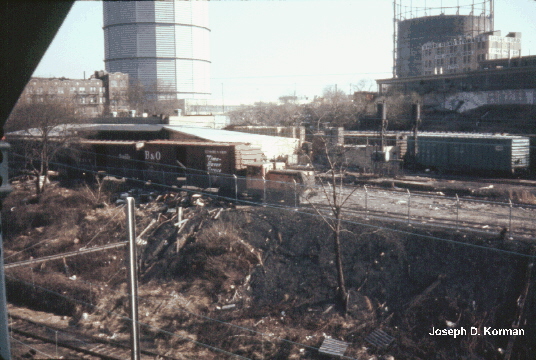
unknown date
J. Korman photo
.
Predating the discovery of the above photo on 14 July 2009; I received an email from Ben Fiorello, who located this G & R Packing webpage on the internet. Ben informed me that he had images of both G & R Packing and the G & R Packing H. K. Porter locomotive from 1970. He was a little cautious in his enthusiasm as he said the images are from an Instamatic, and not of great quality. I immediately replied expressing desire to see those images, knowing all too well, any image is better than no image!
I received the following images, and ran them through my photo editor and present them here for all to view. We are most indebted to Ben for sharing this images!
|
| .
. |
|
| .
. |
|
| .
. |
|
| .
. |
|
| .
. |
|
| .
. |
|
| .
. |
|
.
.
On 02 May 2009, I was staying in Brooklyn after a trip to Staten Island researching the Procter & Gamble Port Ivory remains. I also took the opportunity to stop at the former G& R Packing location.
The property pretty much appears as it does in the aerial imagery, with the property having been paved over and used as a parking lot.
Walking to the extreme west end where the track one rose up from the LIRR right of way, I saw that rubble had been used as a retaining wall, and the track grade had been filled in, allowing the west end of the property to be leveled and more suitably usable as a parking lot. Looking west through the fence and over this "retaining wall", the ground drops off steeply back to the original grading on the right of way. Unfortunately, a vine covered fence prevented a photo of the grade.
Returning to the center of the property, I took a few photos of the structure from a few different angles. Here are three:
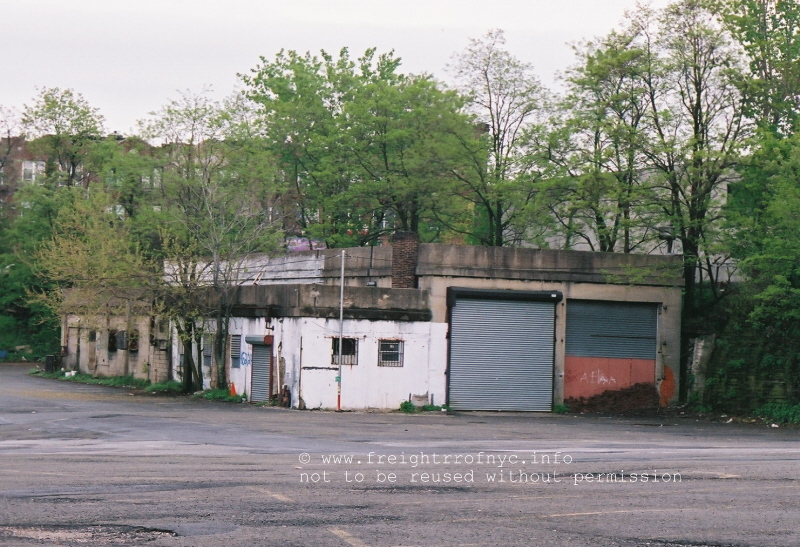
G & R Packing - May 02, 2009
(ex-NYNH&H / LIRR Eighth Avenue Enginehouse - front wall)
(looking east)
authors photo
added 20 May 2009
.
.
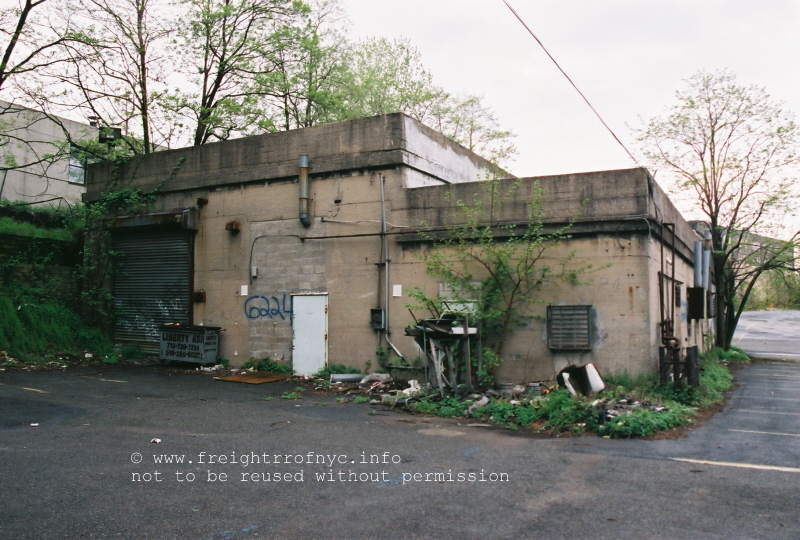
G & R Packing - May 02, 2009
(ex-NYNH&H / LIRR Eighth Avenue Enginehouse - back wall)
(looking west)
authors photo
added 20 May 2009
.
.
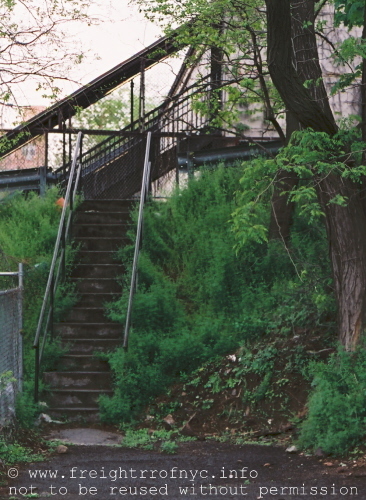
G & R Packing - May 02, 2009
(staircase leading to street level - not believed to be original staircase
as shown on Emery Maps above.
Eighth Avenue BMT Station (N Train) stairs with roof in background. Eighth
Avenue to right)
(looking north)
authors photo
added 20 May 2009
.
Locomotives
.
The Critter - #2
As Matt described to me in our initial telephone conversation, this little switcher, marked with a "Red Ball Express" logo, would pick up freight cars in the "NU" yard of the New York, New Haven & Hartford / Long Island Rail Road, Bay Ridge Division. This yard was located on the north side of the Sea Beach Line (now known as the 'N' Train) of the New York City Transit Authority, and between the Eighth Avenue and Fort Hamilton Parkway stations. This "NU" yard was several blocks east of the Bay Ridge Yard and float bridges.
According to "The New York Connecting Railroad", by R. C. Sturm and W. G. Thom; the New York, New Haven & Hartford / Long Island Rail Road Bay Ridge Division was overhead electrified catenary, from ca. 1927 and was deenergized in 1958. According to R. Emery's notes, the catenary was removed from the G & R Packing property in 1957, and this would explain why the "critter" below was of internal combustion.
Apparently, this Red Ball Express "critter" (for lack of a better word) would pull a freight car or two west, under the Sea Beach "flyover" (which now put the New York, New Haven & Hartford / Long Island Rail Road Bay Ridge Division Right Of Way on the south side of the Sea Beach Line) and stop between 7th and 6th Avenues. At this point, there was a turnout with a rather moderate incline up to street level. The turn out would be thrown and this little locomotive would reverse direction, and shove the freight cars east bound and up the incline to G & R Packing.
Fortunately, for all of us, Matt photographed this critter in January 1962. Before I go any further, it should be stated, that this particular webpage was created due to Matt Herson mentioning the following photograph to me.
Most commonly in my area of research; while a particular property or operation is known, it is the photographs of the equipment that are lacking. In this particular instance, the reverse is true. Here we have a photo of a unique piece of railroad equipment, but little to no history of the operation where it was located and used.
This critter appears to be a custom built with an old truck body. Extensive research through various industrial locomotive photo albums fails to positively identify this locomotive style with any known manufacturer or model (Mack, Davenport, Whitcomb, Brookville, etc). However, the brake rigging appears to have some similarities to a Plymouth DLC type.
This critter appears to be in fair to good cosmetic shape, clean, and carries the "RED BALL EXPRESS" herald on the back of the cab, and a small yellow #2 on the cowl just in front of the cab.
Note the concrete blocks affixed to the four corners of the critter. The purpose of these concrete blocks would be to ballast the critter and add weight, which would give better adhesion for ascending the incline up to the property and buildings from the Bay Ridge right of way. Due to its dimunitive size, (compare with boxcar in image) and even with concrete blocks for ballast, I cannot see this this "locomotive" moving more that 2 loaded freight cars, three at most, up the incline from the Bay Ridge ROW to the building structure.
Also take note of the conventional locomotive bell on the roof of the critter and the reversing light under the cab roof. Whoever constructed this little critter certainly paid attention to detail.
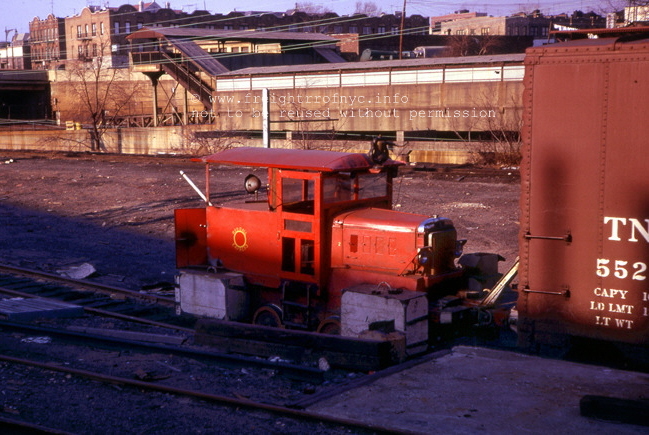
#2 - January 1962
M. J. Herson photo
M. J. Herson archives
added 03 April 09
..
.
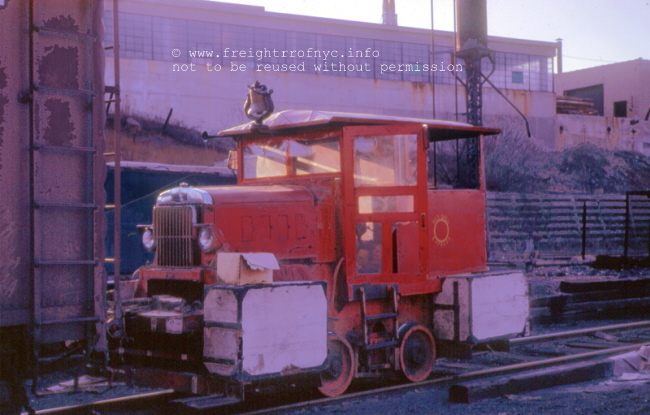
#2 - January 1962
(note sanding tower behind locomotive!
According to R. Emery Map, this was supposed to have been removed in 1957.)
M. J. Herson photo
M. J. Herson archives
added 04 April 09
..
.
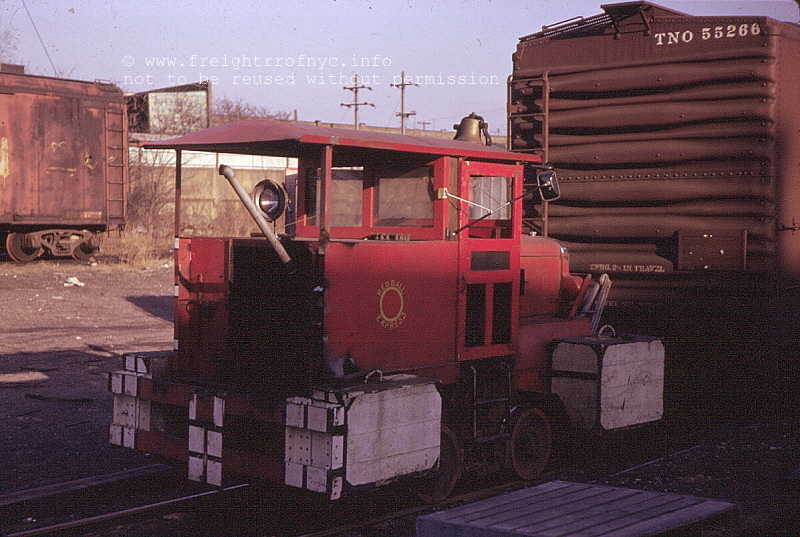
#2 - January 1962
M. J. Herson photo
authors collection
added 02 February
2011
.
.
As mentioned above, the actual firm who constructed this critter remains unknown. However, upon zooming in on the image and closer examination of the grill, the shape of an emblem can be discerned, but not the name. The shape of the emblem bears striking resemblance to the shape of the Autocar emblem:

.
.
Sure enough, upon proofreading this page, Matt found another photo of the #2, and zoomed in on the grill:
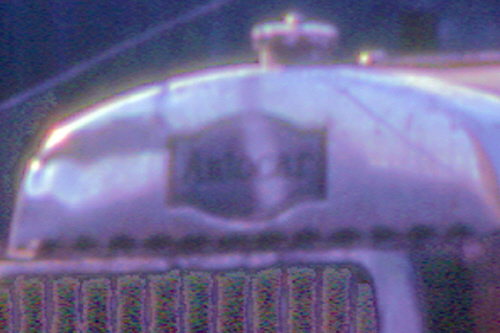
.
.
So, now we have been able to confirm the origins of this unique and most likely one of a kind piece of rail equipment as a former Autocar truck body!
My trusty co-author and sidekick; Joe Roborecky, did a little research on the web, and located some images of early Autocar trucks.
The following three images are all 1930's models, and all bear a striking resemblance to the Red Ball Express #2:
 |
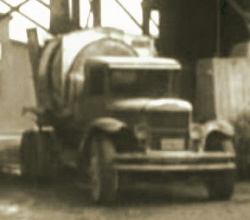 |
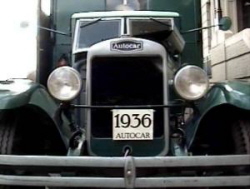 |
||
ca. 1930's Autocar type CA |
... |
1932 Autocar model N |
... |
1936 Autocar (unknown type) |
.
.
Autocar to this day, remains a significant manufacture of "straight job" trucks and tractors for "semi's" / tractor trailers.
As for the history of Red Ball Express, I refer you to the following:
"The Red Ball Express was an enormous convoy system created by Allied forces to supply their forces moving through Europe following the breakout from the D-Day beaches in Normandy. The term "Red Ball" was a railroad phrase referring to express shipping. The system lasted only three months, from August 25 to November 16, 1944, when the port facilities at Antwerp were opened. The term is often used to refer to all WWII European supply convoys by historians and the veterans themselves."
.
What the association this Red Ball Express "locomotive" has with the WW2 material transport of the same name is unclear. Referencing the American Red Ball Moving and Trucking website reveals no connection between the "Red Ball Express" and their firm.
However, there was a trucking firm in the United States following WWII, by the name of Red Ball Motor Freight. This firm was concerned with the over the road haulage of good via truck. A photo recently seen on (where else?) eBay shows several old tractor trailers posed by their warehouse. No location is given but the date is 1929-1930-1931:
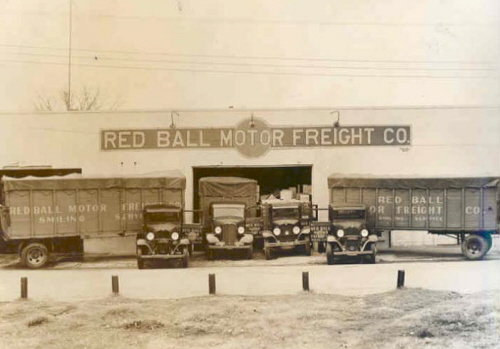
.
Could it be that this "locomotive" was fabricated from the remains
of an old tractor - trailer from this firm (which declared bankruptcy in
1982)? Your guess is as good as mine.
I took the time to contact Jay Reed, who is by my understanding, a well recognized expert on industrial locomotives, critters, etc. Jay was kind enough to review the images of #2 above, but unfortunately, the images above do not bear enough detail for a detailed analysis to determine manufacturer of the chassis.
The disposition of the critter remains a mystery. I would like to hope, due to its unique character, someone else felt about it as I do now and it survives somewhere. But as Jay Reed pointed out, it is kitbashed and heavily modified to start with, so repairs would be more or less slapdash and parts would be hard to find if at all. Jay also pointed out:
"Hanging that much extra weight on such a small locomotive means that they were intending on overloading it to a tremendous degree. If they increased its capacity to start heavy loads, did they also strengthen its clutch and transmission? Probably not, so the poor thing was lucky to survive as long as it did. By the time it was replaced in 1966, this level of overload had probably led to a major failure. Scrap prices were high, and undersized locomotives were dime-a-dozen back then - reality dictates that it's prognosis for survival was grim."
Taking that into consideration leaves little hope this critter has survived and is waiting to be photographed somewhere. Naturally, if anyone reading this webpage, knows the origins and / or disposition or whereabouts of this critter, please contact me at bedt14@aol.com.
.
Porter 20 Ton - no #
Now a few days later (4/18/09), after creating this page, I was in the process of entering key words into my file search on my locomotive builders records. I entered "Bay Ridge" and let Microsoft do some work for me. When the search finished, it showed me that there is word match in the H. K. Porter file, so I opened it, and what do you know:
H. K. Porter locomotive builders records show that construction number 7264 was assigned to a DTC20 demonstrator unit. DTC stands for Direct Torque Control, and the 20, I understand to denote 20 ton. This demonstrator was purchased by the Bullard Company in Bridgeport, Connecticut in October 1941, and lettered "Defense Plant Corp" #10295. On an unknown date, G & R Packing Company purchased this locomotive.
Naturally, a web search fails to provide any information on this model locomotive. After reviewing a H. K. Porter catalog from 1943, I looked at some of the models of 20 Ton locomotives H. K. Porter had to offer. Unfortunately, none seem to have the type of chassis seen in the photo above of "Red Ball Express #2". But, at least we have a logical reason why the Red Ball Express critter would be numbered "2": the Porter, was in all likelihood, the first G & R locomotive.
Jay Reed was able to confirm there were in fact two locomotives for G & R Packing; and Jay furnished an acquisition date of 1966 for the Porter 20 Ton, so it appears #2 preceded the Porter! There is no record of a #1 used at G & R Packing, and it is doubtful even one existed.
The following image, furnished by Ben Fiorello; shows the silhouette of the 20 ton Porter at G & R Packing. Other images in the property chapter above show it in operation.
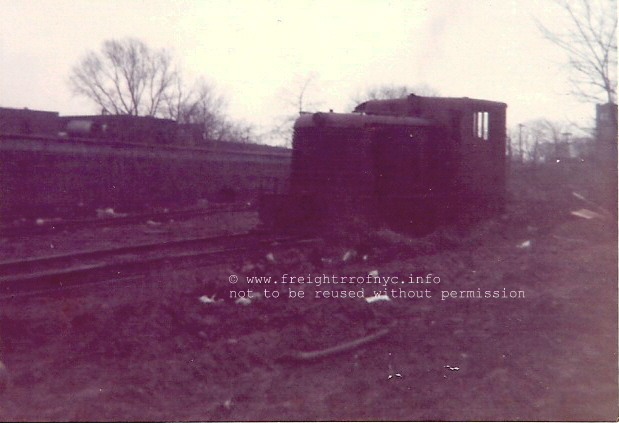
1970
B. Fiorello
photo
added 14 July 2009
.
.
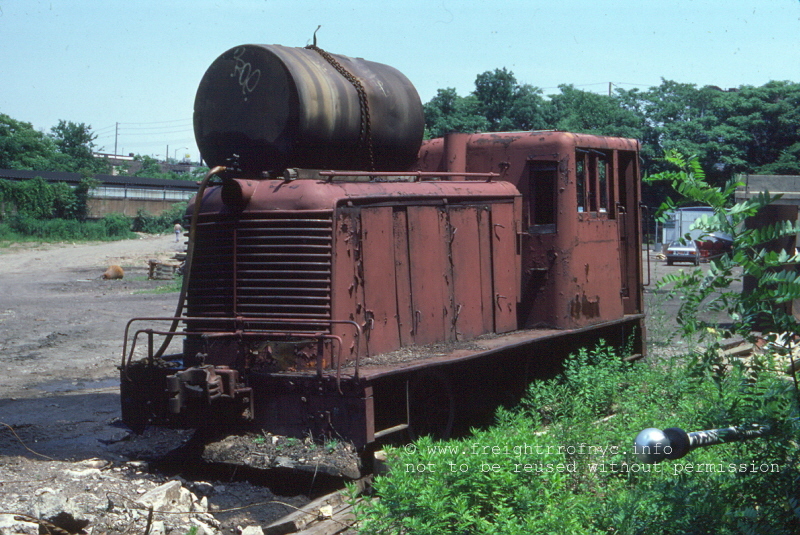
June 1984
Note that all yard tracks appear to have been removed, the locomotive is
"landlocked" or stranded (no connecting trackage)
and is or was used as a elevated platform for the tank.
A. Huneke photo
authors collection
added 26 March 2011
Ben Schaeffer states that the Porter locomotive was on G & R property as late as 1990. The locomotive had been stored in the former LIRR enginehouse following the closure of G & R Packing. When the new owner of the property purchased the land, he had the locomotive dragged outside where it sat for several years. Upon construction of the parking lot, he had a scrapper come in and cut up the locomotive.
.
G & R Packing Roster
| number / name |
builder |
c/n |
build date |
gauge |
wheel arrangement |
wheel dia |
model |
acquired |
disposition |
notes |
ref |
| 2 | unknown | std. | B | unknown | unknown | "Red Ball Express" | |||||
| H. K. Porter | 7264 | 5/1940 | std. | B | DTC 20 DH4 |
used: 1966 Bullard Co, Bridgeport, CT (lettered Defense Plant #10295) |
G. R. Silcott (dealer) Worthington, Ohio scrapped on premises 1990? |
HK Porter Demonstrator Hercules DHXB diesel engine 142 hp |
[3] |
.
Like what you see? Suggestions? Comments?